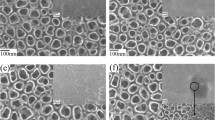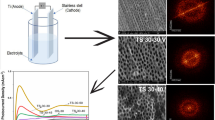Abstract
Preferential orientation of anatase crystals in TiO2 nanotube (TNT) films was induced through an electroreduction pre-treatment prior to annealing at 450 °C in atmospheric air. This pre-treatment consisted of applying a cathodic potential between − 1 and −6 V vs. SCE, using either continuous or pulsed form. Relative to TNTs without pre-treatment, XRD characterization revealed that the ratio of intensities for anatase planes (004) and (101), I(004)/I(101), increased around five times when pulsed electroreduction was carried out at − 3 V versus SCE in a 0.1 M Na2SO4 solution, compared to that obtained without the pre-treatment. Since additional ions were not included in the electrolyte, this result demonstrated that pulsed electroreduction could be used as a simple strategy to preferentially orient TiO2 anatase crystals. However, it was also found that the induction of a preferred crystal orientation in the [001] direction negatively affected TNT photoelectrochemical performance. This response could be attributed to changes induced on the film during the electroreduction process, since electrochemical characterization showed that the electrical and semiconducting properties of the TNTs were drastically modified after pre-treatment. Therefore, these findings reveal that TNT preferential orientation in the [001] direction is not necessarily associated with improved photoelectrochemical behavior and that TNT photoresponse is strongly influenced by the methodology used to achieve such crystalline orientation.










Similar content being viewed by others
References
Roy P, Berger S, Schmuki P (2011) TiO2 nanotubes: synthesis and applications. Angew Chem Int Ed 50:2904–2939
Acevedo-Peña P, González F, González G, González I (2014) The effect of anatase crystal orientation on the photoelectrochemical performance of anodic TiO2 nanotubes. Phys Chem Chem Phys 16(47):26213–26220. https://doi.org/10.1039/C4CP03930K
Lee S, Park I, Kim D, Seong W, Kim DW, Han G, Kim JY, Jung H, Hong K (2012) Crystallographically preferred oriented TiO2 nanotube arrays for efficient photovoltaic energy conversion. Energy Environ Sci 5:7989–7995
Huang J, Tan X, Yu T, Zhao L, Hu W (2014) Enhanced photoelectrocatalytic and photoelectrochemical properties by high-reactive TiO2/SrTiO3 hetero-structured nanotubes with dominant {001} facet of Anatase TiO2. Electrochim Acta 146:278–287. https://doi.org/10.1016/j.electacta.2014.09.043
Yang Z, Ma Z, Pan D, Chen D, Xu F, Chen S (2014) Enhancing the performance of front-illuminated dye-sensitized solar cells with highly [001] oriented, single-crystal-like TiO2 nanotube arrays. Ceram Int 40(1):173–180. https://doi.org/10.1016/j.ceramint.2013.05.119
John A, Naduvath J, Mallick S, Pledger J, Remillar S, DeYoung P, Thankamoniamma M, Philip R (2016) Electrochemical synthesis of novel Zn-doped TiO2 nanotube/ZnO nanoflake heterostructure with enhanced DSSC efficiency. Nano-Micro Lett 8(4):381–387. https://doi.org/10.1007/s40820-016-0099-z
Pan D, Huang H, Wang X, Wang L, Liao H, Li Z, Wu M (2014) C-axis preferentially oriented and fully activated TiO2 nanotube arrays for lithium ion batteries and supercapacitors. J Mater Chem A 2(29):11454–11464. https://doi.org/10.1039/C4TA01613K
Jung MH, Chu MJ, Kang M (2012) TiO2 nanotube fabrication with highly exposed (001) facets for enhanced conversion efficiency of solar cells. Chem Commun 48(41):5016–5018. https://doi.org/10.1039/c2cc31047c
Alivov Y, Fan Z (2009) A TiO2 nanostructure transformation: from ordered nanotubes to nanoparticles. Nanotechnology 20(40):405610. https://doi.org/10.1088/0957-4484/20/40/405610
Sierra-Uribe JH, Córdoba-Tuta E, Acevedo-Peña P (2017) The effect of the heating rate on Anatase crystal orientation and its impact on the photoelectrocatalytic performance of TiO2 nanotube arrays. J Electrochem Soc 164:H279–H285
John A, Naduvath J, Mallick S, Shripathi T, Thankamoniamm M, Philip R (2015) A novel cost effective fabrication technique for highly preferential oriented TiO2 nanotubes. Nano 7:20386–20390
Zhang Z, Hedhili M, Zhu H, Wang P (2013) Electrochemical reduction induced self-doping of Ti3+ for efficient water splitting performance on TiO2 based photoelectrodes. Phys Chem Chem Phys 15(37):15637–15644. https://doi.org/10.1039/c3cp52759j
Zhou H, Zhang Y (2014) Electrochemically self-doped TiO2 nanotube arrays for supercapacitors. J Phys Chem C 118(11):5626–5636. https://doi.org/10.1021/jp4082883
Liao W, Yang J, Zhoua H, Murugananthan M, Zhang Y (2014) Electrochemically self-doped TiO2 nanotube arrays for efficient visible light photoelectrocatalytic degradation of contaminants. Electrochim Acta 136:310–317
Chen X, Liu L, Huang F (2015) Black titanium dioxide (TiO2) nanomaterials. Chem Soc Rev 44(7):1861–1885. https://doi.org/10.1039/C4CS00330F
Yang Y, Liao J, Li Y, Cao X, Li N, Wang C, Lin S (2016) Electrochemically self-doped hierarchical TiO2 nanotube arrays for enhanced visible-light photoelectrochemical performance: an experimental and computational study. RSC Adv 6:46871–46878
Yun JH, Ng Y, Huang S, Conibeer G, Amal R (2011) Wrapping the walls of n-TiO2 nanotubes with p-CuInS2 nanoparticles using pulsed-electrodeposition for improved heterojunction photoelectrodes. Chem Commun 47:11288–11290
Seferlis A, Kollia M, Neophytides S (2015) The in situ electrochemical stable promotion of photoelectrocatalytic activity of TiO2 by pulsed reductive doping: application in photoelectrochemical water splitting. J Electrochem Soc 162:H397–H402
Carrera-Crespo JE, Rincón M, González F, Barrera E, González I (2016) Improving the contact properties of CdS-decorated TiO2 nanotube arrays using an electrochemical/thermal/chemical approach. J Solid State Electrochem 20:2713–2723
Acevedo-Peña P, Carrera-Crespo JE, González F, González I (2014) Effect of heat treatment on the crystal phase composition, semiconducting properties and photoelectrocatalytic color removal efficiency of TiO2 nanotubes arrays. Electrochim Acta 140:564–571. https://doi.org/10.1016/j.electacta.2014.06.056
Park I, Kim D, Seong W, Han B, Jung H, Yang M, Fan W, Lee S, Lee JH, Hong K (2015) Observation of anatase nanograins crystallizing from anodic amorphous TiO2 nanotubes. CrystEngComm 17(38):7346–7353. https://doi.org/10.1039/C5CE01165E
Regonini D, Groff A, Sorarù GD, Clemens FJ (2015) Photoelectrochemical study of anodized TiO2 nanotubes prepared using low and high H2O. Electrochim Acta 186:101–111. https://doi.org/10.1016/j.electacta.2015.10.162
Regonini D, Groff A, Sorarù GD, Clemens FJ (2016) Suppressing deep traps in self-organized TiO2 nanotubes by Nb doping and optimized water content. J Electrochem Soc 163(3):H243–H251. https://doi.org/10.1149/2.0131605jes
Yahia S, Hamadou L, Kadri A, Benbrahim N, Sutter E (2012) Effect of anodizing potential on the formation and EIS characteristics of TiO2 nanotube arrays. J Electrochem Soc 159:K83–K92
Amano F, Nakata M, Yamamoto A, Tanaka T (2016) Effect of Ti3+ ions and conduction band electrons on photocatalytic and photoelectrochemical activity of rutile titania for water oxidation. J Phys Chem C 120(12):6467–6474. https://doi.org/10.1021/acs.jpcc.6b01481
Wu L, Bresser D, Buchholz D, Giffin G, Castro C, Ochel A, Passerini S (2015) Unfolding the mechanism of sodium insertion in anatase TiO2 nanoparticles. Adv Energy Mater 5(2):1401142. https://doi.org/10.1002/aenm.201401142
Bisquert J, Fabregat-Santiago F, Mora-Seró I, Garcia-Belmonte G, Barea E, Palomares E (2008) A review of recent results on electrochemical determination of the density of electronic states of nanostructured metal-oxide semiconductors and organic hole conductors. Inorg Chim Acta 361(3):684–698. https://doi.org/10.1016/j.ica.2007.05.032
Jankulovska M, Berger T, Wong S, Gomez R, Lana-Villarreal T (2012) Trap states in TiO2 films made of nanowires, nanotubes or nanoparticles: an electrochemical study. ChemPhysChem 1:3008–3017
Bessegato G, Hudari F, Boldrin M (2017) Self-doped TiO2 nanotube electrodes: a powerful tool as a sensor platform for electroanalytical applications. Electrochim Acta 235:527–533
Nischk M, Mazierski P, Wei Z, Siuzdak K, Kouame N, Kowalska E, Remita H, Zaleska-Medynska A (2016) Enhanced photocatalytic, electrochemical and photoelectrochemical properties of TiO2 nanotubes arrays modified with Cu, AgCu and Bi nanoparticles obtained via radiolytic reduction. Appl Surf Sci 387:89–102. https://doi.org/10.1016/j.apsusc.2016.06.066
Bisquert J, Garcia-Belmonte G, Fabregat-Santiago F, Ferriols N, Bogdanoff P, Pereira E (2000) Doubling exponent models for the analysis of porous film electrodes by impedance. Relaxation of TiO2 Nanoporous in aqueous solution. J Phys Chem B 104(10):2287–2298. https://doi.org/10.1021/jp993148h
Acknowledgements
The authors are grateful to project CONACYT-México (270810) for the financial support. The authors thank LDRX (T 128) UAM-I for the XRD measurements. The authors thank the Laboratorio Nacional de Conversión y Almacenamiento de Energía (LNCAE) for some of the infrastructure required for material characterization.
Funding
Harrison Sierra-Uribe would like to thank Colciencias and Vicerrectoría de Investigación y Extensión from Universidad Industrial de Santander for the financial support provided through the “Jóvenes Investigadores” fellowship (Convocatoria No.706, 2015).
Author information
Authors and Affiliations
Corresponding author
Ethics declarations
Conflict of interest
The authors declare that they have no conflict of interest.
Electronic supplementary material
ESM 1
(DOCX 188 kb)
Rights and permissions
About this article
Cite this article
Sierra-Uribe, H., Carrera-Crespo, J.E., Cano, A. et al. Electroreduction as a viable strategy to obtain TiO2 nanotube films with preferred anatase crystal orientation and its impact on photoelectrochemical performance. J Solid State Electrochem 22, 1881–1891 (2018). https://doi.org/10.1007/s10008-018-3890-6
Received:
Revised:
Accepted:
Published:
Issue Date:
DOI: https://doi.org/10.1007/s10008-018-3890-6




